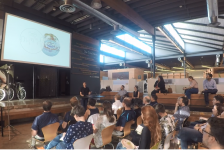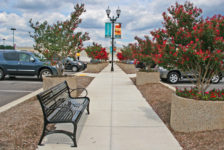I am a 2011 graduate of Ball State University’s BLA program and I am proud to say that I work in the residential design field. However, if you had asked me four years ago where my future would take me, I would never have guessed correctly. Let me explain why.
Of the many lessons learned and attitudes absorbed in an undergraduate landscape architecture program, there is one that is especially contagious – the stigma against residential design as a valid career choice. It may start in the form of offhand comments from professors or a witty T-shirt boasting “I’m an LA and I won’t design your garden!” No matter the avenue, this stigma may be detrimental to the career of a recent graduate.
In LAM’s May 2013 issue, editor Bradford McKee suggests that LAM’s readers might want to take medication before reading the magazine to treat the symptoms of what I like to call “Residential Design Phobia” (RDP). He thought they would “recoil at the thought of something they consider too close to housework.” While this is not a new reaction by any means, I agree very strongly with a subsequent letter to the editor on the topic of this stigma. Alan Burke, a landscape architect from the Seattle area who has been practicing in the residential sector for over 20 years, expertly points out that the editor’s veiled apology for creating an entire issue dedicated to residential work only perpetuates designers’ distaste for it. I agree wholeheartedly with his statement:
“While design/build and residential work could instead be a bedrock of training, you ensure that no self-respecting landscape architecture graduate would be caught dead doing it.”
Sadly, I myself contracted Residential Design Phobia in college. However, the last two years – the first two of my career– have proven to be the best course of treatment for the ailment. While working at a small residential design firm in the Washington DC area, I’ve learned that residential design might well just be the answer to many recent graduates’ prayers.
Eight Lessons Recent Graduates will learn from Residential Design:
- Residential design is personal. Public work is thrilling to work on and visible when built, but imagine the satisfaction you will have when a happy residential client thanks you for improving their home, and by extension, their quality of life.
- It is a business. Remember all of those courses you took to learn how to run a business? Neither do I. Take an opportunity to work in the residential sector to learn firsthand all you can about writing contracts, determining a fee, drafting emails to clients, and working on site with the construction team.
- Clients and contractors want hard facts and logical decisions. What better way to learn how to communicate with them than to practice, practice, practice?
- Can you think of one project in college that required you to design within a particular budget? When a homeowner is willing to pay for improvements on their property, budget is everything.
- Simple designs work best. Often the design solution is staring you in the face.
- Not everything goes together as easily as LEGOs. Construction details that you draft have real-world applications. Spend as much time on construction sites at the start of your career as you can.
- Working in the residential design field requires a multitude of skills. Since the design team is often smaller and more hands-on, each member is required to diversify his or her talents and accept more responsibility than at a firm that works in the public sector.
- You will never be bored. It is common to be juggling up to a dozen projects at once. While not lacking complexity, residential projects move toward completion more swiftly than projects in other sectors. This provides more opportunity for creativity and collaboration.
These are just a few of the lessons I’ve learned since graduation. The keystone to all of this, however, is a willing mentor. Luckily, the small size of most residential design firms is conducive to fostering successful business relationships between recent graduates and design veterans.
I can only hope that more future designers give residential design a chance. It might just be what they have been waiting for. I, for one, am happy to have been cured of my own case of RDP.
by Lindsey Tabor, ASLA. The above article was originally posted on ASLA’s The Field.
Lead image via Will Folsom
Published in Blog










Jesse York
Lindsey, these are some great points. I too graduated from school with this “snobby” attitude. I went to work for a large firm and found myself stuck in a cubicle behind a computer doing extremely boring things. I quickly jumped into residential work and haven’t turned back.
While some of the work can be tedious (just like any job), who else can see their creative visions turned into reality so often?
Another thing you didn’t mention is there is greater financial opportunity in residential design.
Best, Jesse
Naomi Z Brooks
I totally agree. No need for our profession to sniff at residential work. Those smaller projects are where a newcomer to a firm can learn about a wide variety of things in a short time. There are not nearly the amount of frustrating meetings and endless CAD revisions as with municipal, institutional or commercial projects; although the scale is smaller, you gain the ability to source and procure a variety of interesting products; and my favorite: being allowed out on planting day <grin>.
I liken the snobbery to academia: the higher education professors get most of the respect, yet I truly believe the first educators in our lives – parents and elementary school teachers – shape who we are and how we think in a much deeper and more important way.
What could be better than to help create personalized outdoor residential space?
Rebecca R.
Great article, Lindsay! I had a similar experience when I graduated in 2012. I’d add that not only do you get to learn how to work within a budget; homeowners’ budgets can potentially be more flexible, allowing you to personally present them interesting solutions that they may fall in love with and be willing to accommodate. I’ve found developers or municipalities to be much less willing to try anything new, especially if it means spending a little extra. (Sure, there are plenty of stubborn homeowners, too; I guess what I’m trying to get at is that since they are both the client and the end user they’re more likely to entertain innovative ideas.)
J. Robert (Bob) Wainner
Hi Lindsey;
GREAT article! I agree. Although my first 13 yrs. as an LA was a mix of commercial, retail, residential & multi-family….they were all good in giving me experience I need to further my LA career.
The LA firm I worked for in Dallas for 12 yrs., focused heavily on upscale multi-family. So, when I went on my own…well, I started mostly with “residential – single family”…as I was totally self-employed – a one man LA firm. But, the multi-family projects started coming in like gang busters…I was buried with work. I tend to think of multi-family as residential…more so than commercial. It has many of the same challenges and design elements you deal with that you deal with when designing “single family” projects. I sort of moved away from “single family” due to my heavy multi-family work load…but, still managed to squeeze a few single family projects into my schedule.
And, like you said, you’ll learn “quickly”….about writing contracts, designing within budgets, project observation & inspection trips, dealing with contractors and clients, dealing with other design professionals, marketing your services, etc.
Also, with BOTH multi-family & single family residential projects….I have found that you CAN handle these projects while being “self-employed”. And yes, you can also make a very good living designing these types of LA projects.
Regards,
Bob
Lindsey Tabor
Thanks for the great feedback everyone! It’s been very refreshing to see that others in the landscape architecture field aren’t shy about declaring their love for residential design – or at least the desire to defend it. If only others would join in on the fun!
Maria Torres
Lindsey!
Thank you so much for posting this! This is extremely helpful. Being a recent grad myself, class of 2013, I find that many of us do have a phobia for residential design. Thank you for showing us the other side of the coin!
Best,
Maria
Ted
Lindsey, I want to echo the earlier comments: this is a really spot-on assessment of the residential design niche within our very broad profession! As a sole practitioner for whom at least 90% of my projects are that type, every point really resonated with me…..from the intimate involvement of all aspects of the project, to the unique budget concerns both good & bad, to the challenges of so much time & effort needed on the generic business tasks of simply making a living. And if you like interacting with people — maybe the very wealthy, one hour, then the most salt-of-the earth contractor the next — this is hugely satisfying.
As a young LA, I found, personally, being stuck in front of a CAD workstation to be quite a disappointment early in my career. It became mostly abstract digital lines without the crucial link of getting out there on the jobsites to understand the whys & hows of what the real project in the ground was all about. (To be fair, there are probably firms that offer a better experience than mine was.) Gravitating toward a garden design focus offered a much quicker route to responsibility. “Out there” is where it really matters, not on the drawing table or computer monitor. Even now, I advise students to get outside that studio they’ve been holed up in till 2 in the morning, and simply go run their hands along the bark of a tree or dip them in the water of a fountain. Ours is not only an intellectual pursuit, it’s a sensual one.
I think a big reason for that perplexing LA snobbery of “no, I won’t design your garden” is that most of the public equates landscape design with the mundane, marginally-competent, and uninspired stuff 99 out of a hundred landscape contractors provide. Relatively very few people are ever exposed to the level of beautiful and sophisticated private gardens that the star LA firms create either occasionally or as their core project type. Fact is, we (and I’d like to think most all the public too, even if they can’t articulate why) can almost always spot a garden designed by an LA in a heartbeat compared to one done designed by a contractor. It’s just the intangible stuff we absorb in five years of design schooling— compared to a couple of Design 101 courses at a community college — that make all that difference; how we study — and are constantly challenging ourselves with — all those design concepts of space-making & detailing & historic references & on & on. Some of the most important LAs of the 20th century — Garrett Eckbo and Tommy Church come to mind — no matter how influential they became or (in Eckbo’s case) how huge his firm grew, understood that the garden was a fertile place to incubate design ideas, and thus just as important a project as a 50-acre inner city park.
Thanks for helping address this “I don’t get no respect!” topic. You have the kind of insight that suggests a really successful career ahead of you.